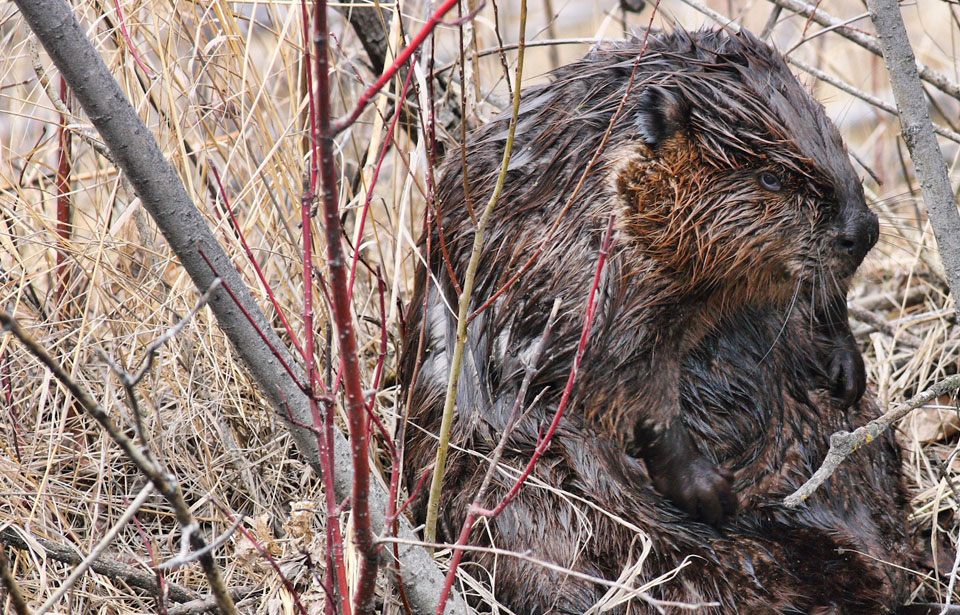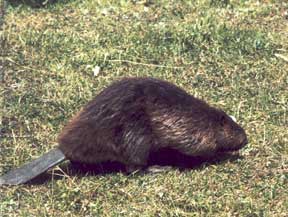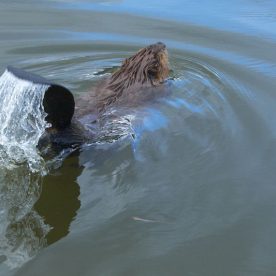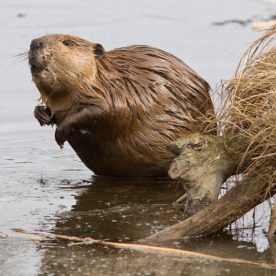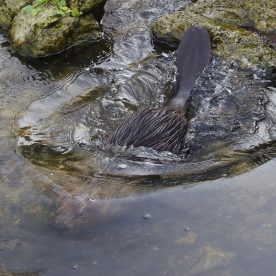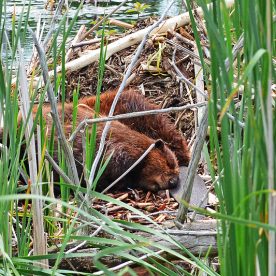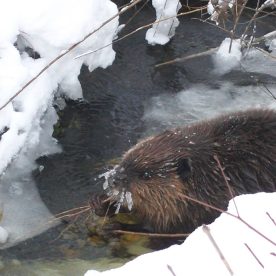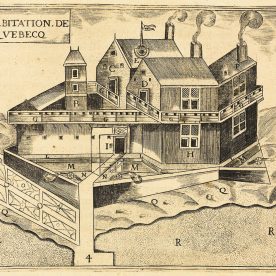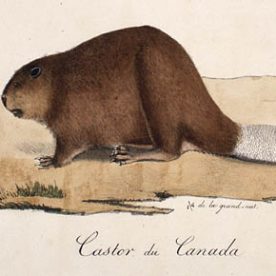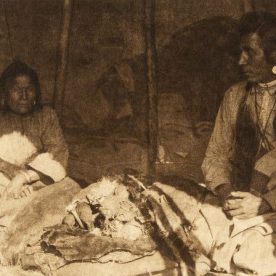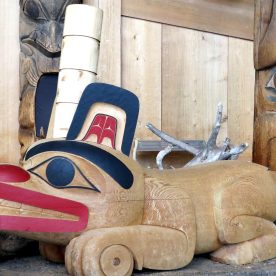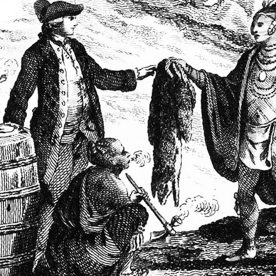Description
The beaver Castor canadensis is the largest rodent in North America and the largest rodent in the world except for the capybara of South America. On average, an adult weighs from 16 to 32 kg and, including its 30-cm tail, a large beaver may measure 1.3 m long. Some may even weigh more than 45 kg! Its ancestors were even larger. In the Pleistocene ice age—the era of the mastodons and the mammoths—the giant beavers that inhabited the expanses of Eurasia and North America measured just under 3 m in length, including the tail, and probably weighed 360 kg.
Being short and rotund, the beaver is ungainly and slow on land. Not so in the water. The beaver is a graceful, strong swimmer, both under water and on the surface, attaining speeds approaching 7 km per hour if it is alarmed.
The beaver’s body is adapted in many ways to the animal’s watery habitat. The beady eyes see as well in the water as out of it thanks to a specialized transparent membrane that can be drawn over the eyes for protection while diving. The nostrils are small and can be closed for underwater swimming, as can the ears.
The beaver’s tail has important uses both in the water and on land. The tail of a large beaver may be 30 cm long, up to 18 cm wide, and 4 cm thick. It is covered with leathery scales and sparse, coarse hairs. Although fat, the tail is flexible and muscular. In the water, the animal can use its tail as a four-way rudder. On land, the tail acts as a prop when the beaver is sitting or standing upright. It also serves as a counterbalance and support when the animal is walking on its hind legs while carrying building materials like mud, stones, or branches with its front paws.
The beaver’s hind feet are very large, with five long blunt-clawed toes which are fully webbed, for swimming. In the water, the beaver holds its forepaws close to its body, using only its hind feet to propel itself, with occasional aid from its tail. Its forepaws are small, without webs, and the toes end in long sharp claws suited to digging. These delicate paws are very dexterous—almost like hands—and with them the beaver can hold and carry sticks, stones, and mud and perform a variety of complex construction tasks.
The beaver also uses its paws to groom its coat. The second toe on each hind foot is double-clawed, the claws being hinged to come together like tiny pliers. These specialized claws, along with the front claws, are used for grooming the fur, which is brown in colour.
The beaver has several reasons to groom itself. Its fur is very dense, consisting of a mat of fine underfur about 2 cm long and an outer layer of heavy guard hairs about 7 cm long. Through constant preening and oiling, this dense pelt is kept waterproof: even after swimming under water for six or seven minutes the beaver is not wet to the skin. Oil is obtained from two glands near the anus and, like preening, application of oil is done with both front and hind feet. Preening also removes dirt, straightens matted fur and removes mites and other insect parasites. Members of family groups spend considerable time preening each other. The beaver moults in spring and in late autumn.
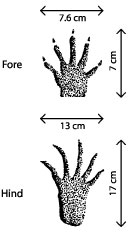
Finally, the animal has exceptional teeth. Its long, sharp, strong incisors grow continuously and are hardened with a dark orange enamel on the forward face. Consequently, as the upper and lower incisors are ground against each other, the outer tips of these teeth are maintained chisel-sharp. With them, a beaver is able to fell very large trees. The lips can be closed behind the incisors, permitting the beaver to gnaw on twigs while under water.
Beavers may live as long as 12 years.
Signs and sounds
Beavers have a system of communication that includes physical markers and noises. They often leave “mud pies” on their trails, on which they leave paw prints and the oily deposit of a musky oil that they secrete. (See Figure 1 for illustrations of their tracks.) They also communicate through low whines and bellows and the pistol-shot-like slap of the tail on water, which warns other beavers that danger is near.
Habitat and Habits
The beaver’s life is inextricably connected to cutting trees—for sustenance and for habitation. This animal cuts down an average of 216 trees a year. It can fell trees up to about 40 cm in diameter. Usually a single beaver cuts a tree, but sometimes two work on a large one.
The beaver is a wonderful builder, and what it builds depends on where it lives. Its best-known structure, the dam, can be built by beavers that need to enlarge the underwater habitat that will be open to them in winter. The dam creates a pond deep enough not to freeze to the bottom, providing a way to transport food by swimming and storage for winter food, and by giving year-round underwater access to the lodge secure from predators.
The beaver begins the dam by laying sticks and rocks in the stream bed at a narrow point in the river where the current is fastest. It embeds some sticks so that the butt ends face upstream, allowing the current to spread the branches more securely on the bottom and pack the stones, roots, and mud that complete the dam into the spaces between the twigs and leaves. Layer upon layer is added, and the result is a very stable earthwork that can withstand great water pressure and erosion. Dams as high as 5.5 m have been discovered.
Dams are maintained throughout the year, but the beavers add most material during periods of high water. Breaks in dams are infrequent, probably because of daily inspection and maintenance.
The beaver also builds a lodge, which may be occupied for many years. Located in the middle of a pond or on the bank of a waterway, this structure can be built from scratch in one month if an older lodge is not available. The lodge includes a feeding den, a resting den, a source of fresh air, and at least two underwater entrance tunnels, which allow for a means of escape if a predator enters the lodge through one of the tunnels. The dens are constructed on a platform approximately 10 cm above the water line so that they will remain dry. The beavers create them by gnawing out space in the pile of mud, twigs, and bark that constitute the lodge.
The size of the lodge depends on the size of the family group, number of years of occupation, and fluctuating water levels. Most lodges are about 5 m in diameter and about 2 m high. As freezing weather begins, the beavers, using their front paws, plaster the lodge with mud, except about the air intake near the top, making a concrete-like outer shell which no wolf, wolverine, or lynx can break through.
Another impressive feat of beavers is the building of canals. Canals may extend several hundred metres along the base of a wooded hillside. Often 1.5 m wide and 1 m deep, they provide easy transportation for food supplies. Sometimes canals are dammed to maintain the water level on uneven ground.
Range
Beavers are found throughout Canada, north to the mouths of the Mackenzie and Coppermine rivers on the Arctic Ocean. In the rest of North America, the beaver’s range extends throughout southwestern Alaska and most of the states south of the 49th parallel. The beaver has been exterminated in some states, and in practically all of its former range in northern Mexico.
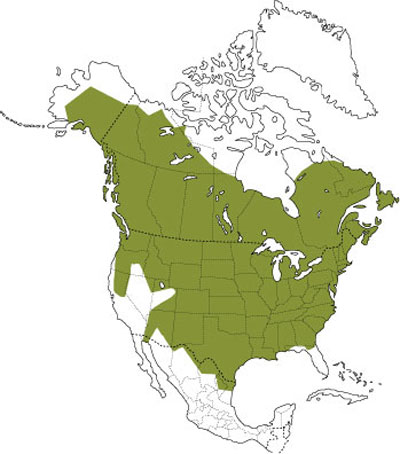
Distribution of the beaver
Feeding
To withstand the winter, beavers in northern latitudes must construct food caches in deep water close to the lodge or bank den they have constructed. Each cache is an accumulation of the beavers’ favourite woody food items, and it is meant to sustain the beavers in the winter. Starting in the summer, the animals begin to prepare the cache by clearing trees away from the edge of the water. If the area is relatively free of predators, the beavers take their logging operation farther afield—often 125 m away. They gnaw the trees into short lengths and tote them to the water, along trails that they have cleared, for underwater storage.
The bulk of the edible forage, or food, in the cache is held below the water surface by a thick top layer of small, leafy branches most often cut from trees and shrubs that are not the beavers’ most preferred (see Figure 2). The top layer protrudes well above the water surface, where it intercepts snow to provide an insulating cover that prevents water from freezing in and around the stored food.
| Figure 2: Beaver lodge, food cache, and dam in water
|
Throughout the winter, the beavers bring sticks from their underwater cache into the feeding chamber of the lodge to gnaw the succulent bark. They prefer trembling aspen, poplar, willow, and birch; half a hectare of aspen will support one beaver for a year. They also swim out under the ice and retrieve the thick roots and stems of aquatic plants, such as pond lilies and cattails. During mild winters and warm days in March and early April, adult beavers emerge from their dull aquatic world to feed on fresh woody stems along the shore. On such forays they can fall prey to hungry fishers, coyotes, hawks, grizzlies, black bears, river otters, lynx, eagles, cougars, owls, wolverines and wolves.
Beavers shift from a woody diet to a herbaceous diet as new growth appears in the spring. While they still may eat the woody stems of shrubs during summer, beavers will mainly eat grasses, herbs, leaves of woody plants, fruits, and aquatic plants.
Beavers shift from a woody diet to a herbaceous diet as new growth appears in the spring. During summer, beavers will eat grasses, herbs, leaves of woody plants, fruits, and aquatic plants.
Breeding
A beaver takes only one mate, which it keeps for life. The family is the basic unit of the beaver’s society, and the female is the central figure. The female usually establishes the home site, and if her mate is lost, she remains with her family, and another male joins her in the mating season. If the female is killed and leaves no female offspring, the male usually abandons the site.
Mating occurs in January and February within the lodge. Shortly before the kits are born, the female drives the male from the lodge the beavers have built, and he moves temporarily into an old lodge or a burrow in the riverbank. One litter, averaging three or four kits, is born each year in May or June following a 100-day gestation period. The young measure about 125 mm long and weigh about 450 g. Although they are well-furred, have teeth already cut, and can see, walk, and swim when born, the kits generally do not move out of the lodge for at least one month. If the kits are threatened, the female will usually carry them in her mouth, under water, to another retreat. The young stay with their parents until they are two and sometimes three years old. They do not work the first summer, but the second season they help with many colony chores, including cutting food, repairing the dam and lodge, and digging channels and canals.
The kits disperse the following spring in response to an innate urge to leave the home colony, and migrate along streams or across country until they find mates and suitable building sites, whereupon they establish their own dams and lodge. These dispersal migrations can vary from just a few kilometres to 250 km along large river systems.
Conservation
Although their aquatic habits offer excellent protection from predators, beavers are vulnerable in many ways. Beavers fall prey to wolves, coyotes, bears, lynx, and wolverines when foraging on shore or migrating overland. The river otter is able to enter the den via the water and kill the kits inside; however, an adult or subadult beaver always stays with the kits to offer protection. Sudden fluctuations in water levels can force beavers to leave their den and face danger on shore.
At bay, beavers stand their ground and protect themselves. They face the aggressor, rear up on their hind legs, and loudly hiss or growl before lunging forward to deliver extremely damaging bites.
During the peak of the fur trade era, some 200 000 pelts a year were sold to the European market, most being used to make the then-popular beaver hats. A large adult beaver skin yielded enough fur for 18 hats.
About 100 years ago, the trade in beaver waned, partly with the decline of the beaver hat as fashionable headgear, and partly because the beavers themselves were becoming scarce all over North America. Many large regions were completely without beaver during most of the first half of the 20th century.
The beaver conservation movement began in the late 1930s with the writings and lectures of Grey Owl. A native of England who posed as a Métis, Grey Owl created passionate stories of the plight of the Canadian forests and wildlife, and particularly the beaver. Governments responded by closing the beaver trapping seasons for many years.
More recently, conservation plans have been put into effect by federal and provincial governments, with the co-operation of trappers, and beavers have been reintroduced into many areas that were stripped by early trappers. As a result, there has been a tremendous increase in the number of beavers in Canada, and their population is now a healthy one.
In some areas the problem is not how to protect the beaver population, but how to prevent damage to farmlands, roads, and tree plantations from beavers’ damming and cutting practices. A combination of trapping and use of flood control devices is necessary. Beavers maintain water levels, improve habitat for many forms of wildlife, stabilize stream flow, and prevent stream bed erosion, so it is important that they be managed carefully.
No other animal has influenced Canada’s history to the extent that the beaver has. When Europeans began to settle in northern North America, beaver pelts were the prize that lured them farther and farther into the wilderness. Canadians now celebrate the beaver as a national symbol on stamps, coins, and emblems; in addition, literally hundreds of Canadian lakes, towns, rivers, and hill ranges bear the name of this interesting rodent.
Resources
Online resources
Northeast Furbearer Resource Technical Committee
Natural History Notebooks, The Beaver
National Geographic, The Beaver
Print resources
Banfield, A.W.F. 1974. The mammals of Canada. University of Toronto Press, Toronto.
Chapman, J.A., and G.A. Feldhamer, editors. 1982. Wild mammals of North America: Biology, management, and economics. The Johns Hopkins University Press, Baltimore and London.
Grey Owl. 1935. Pilgrims of the wild. MacMillan Canada, Toronto. Reprinted 1973.
Murie, O.J. 1954. A field guide to animal tracks. Houghton Mifflin Co., Boston.
Novak, M., J.A. Baker, M.E. Obbard, and B. Malloch, editors. 1987. Wild furbearer management and conservation in North America. Ontario Ministry of Natural Resources, Toronto.
Rue, L.L. III. 1964. The world of the beaver. J .B. Lippincott Co., Philadelphia, Pennsylvania.
Seton, E. T. 1909. Life-histories of northern animals. Volume 1. Grass-eaters. Arno Press, New York. Reprinted 1974.
Wooding, F.H. 1982. Wild mammals of Canada. McGraw-Hill Ryerson Ltd., Toronto.
© Her Majesty the Queen in Right of Canada, represented by the Minister of the Environment, 1973, 1978, 1990, 2003, 2005, 2017. All rights reserved.
Revision:
Garry Trottier, 1989, 2003
Dr. Glynnis A. Hood, 2017
Professor of Environmental Science
University of Alberta, Augustana Campus
Editing:
Maureen Kavanagh, 2003, 2005
Annie Langlois, 2017



